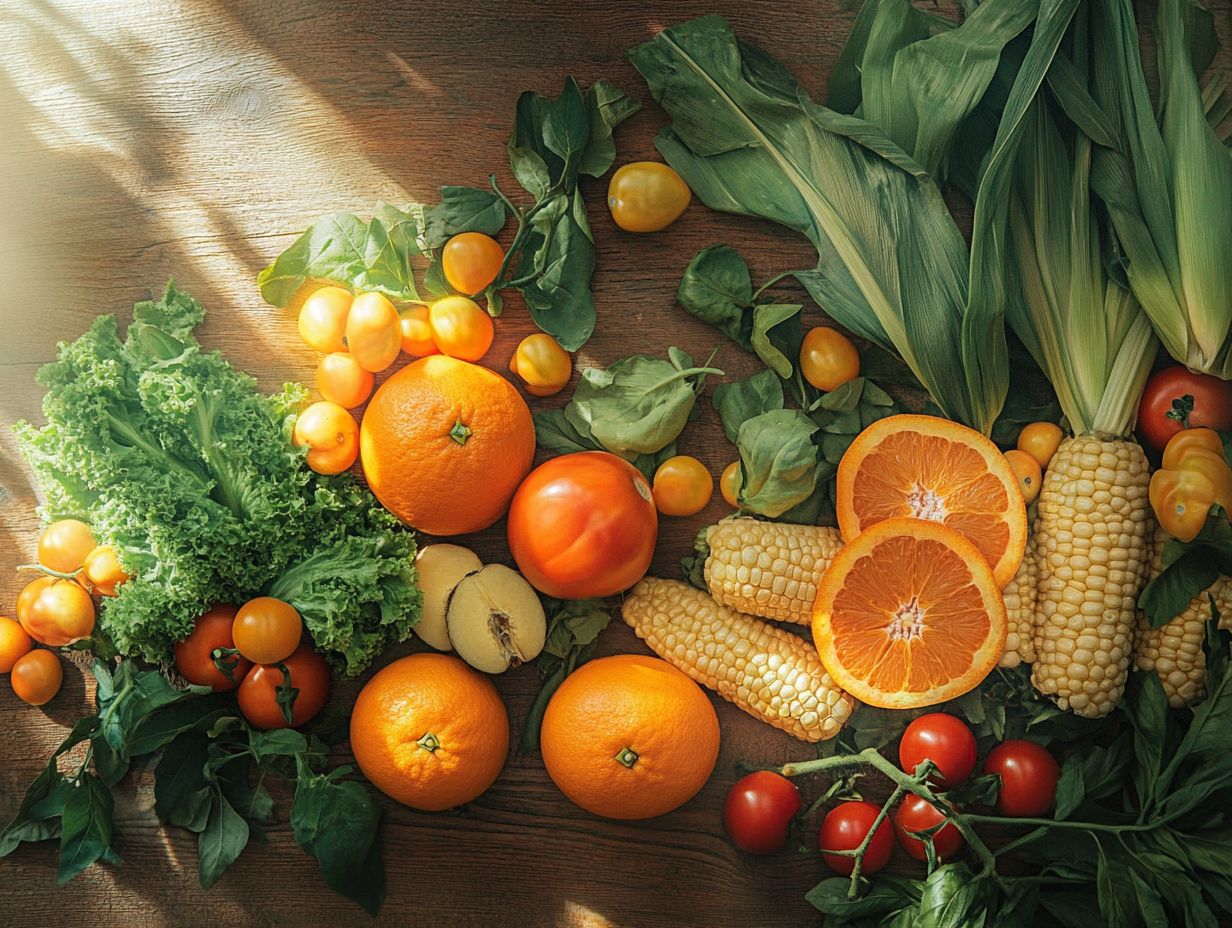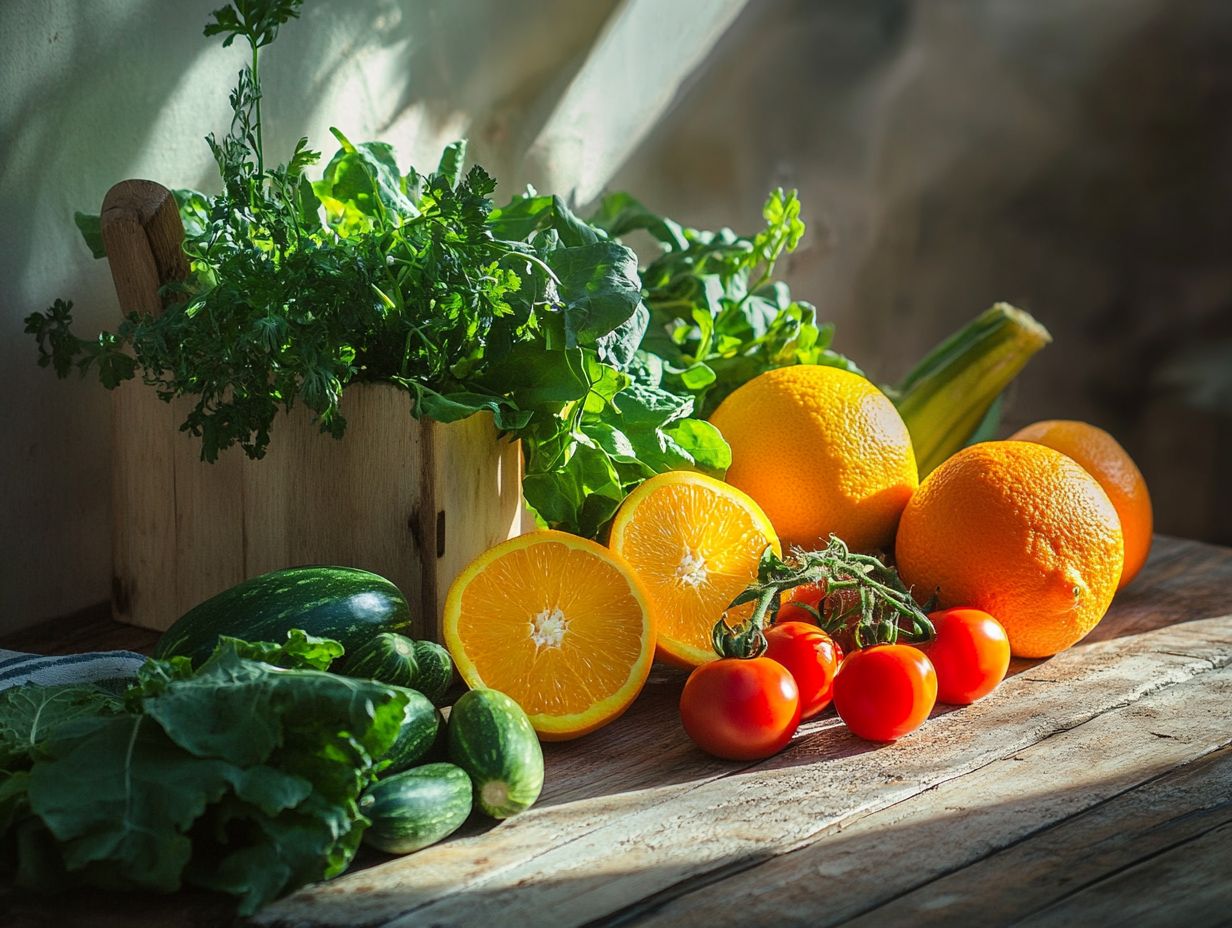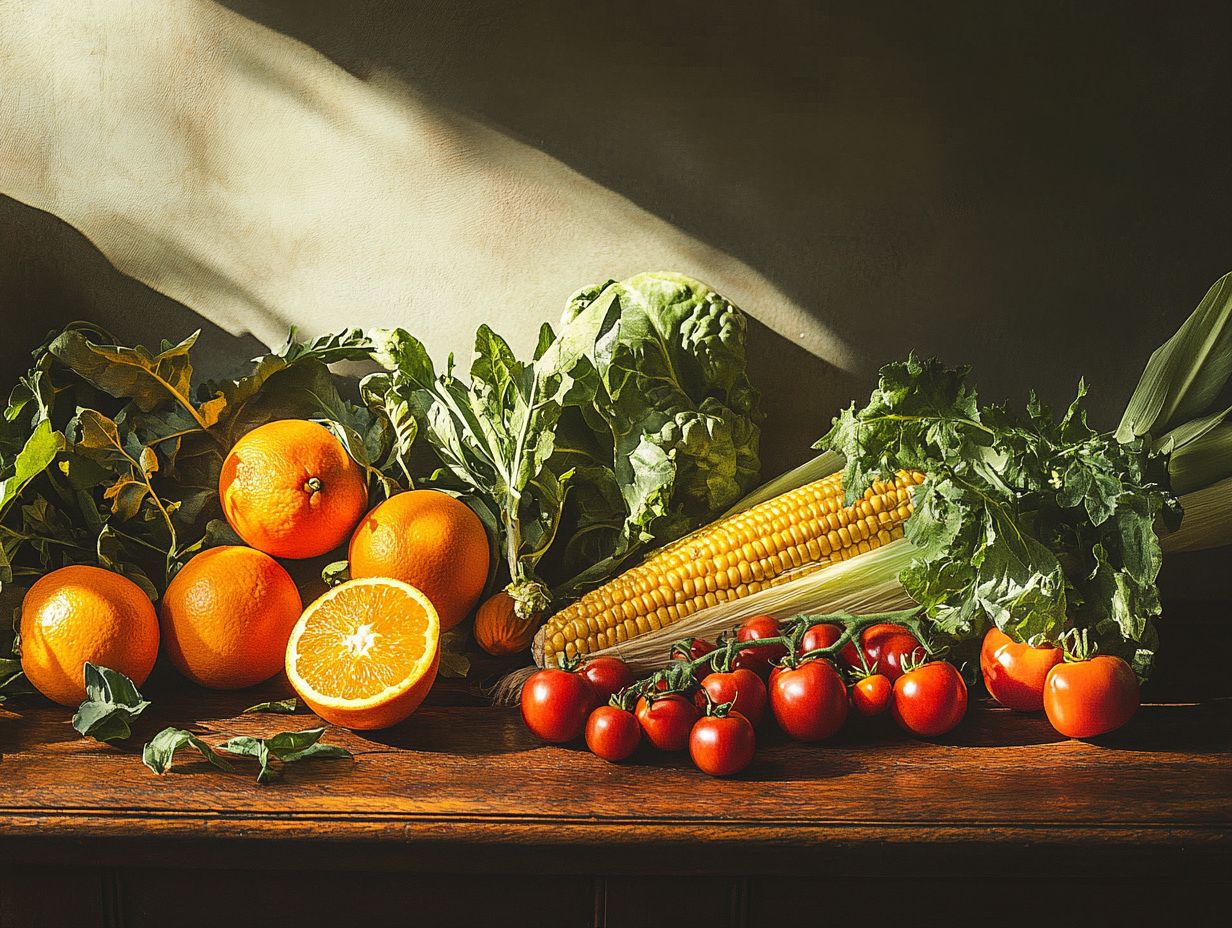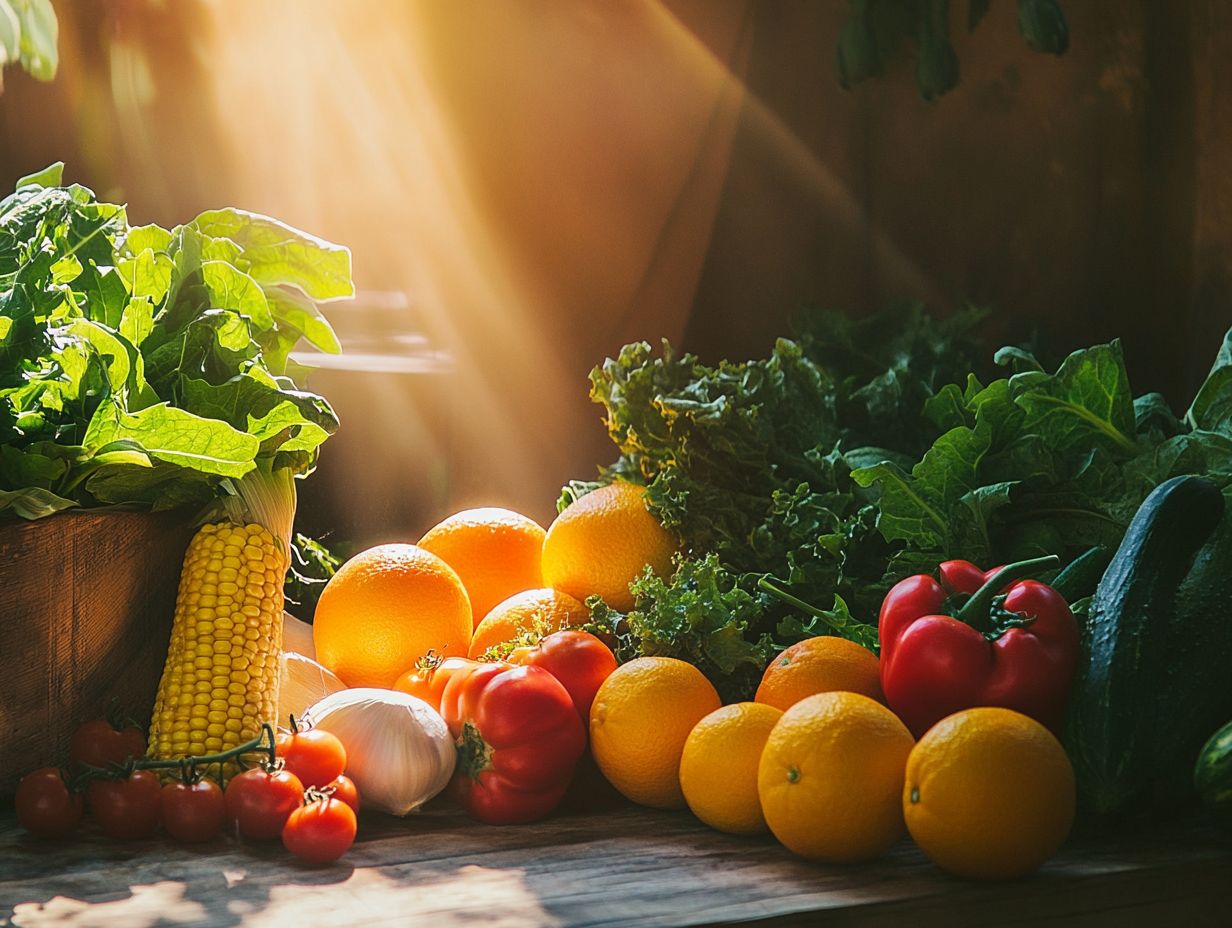The Importance of Eating Seasonal Produce
Eating seasonal produce isn’t merely a trend; it’s a lifestyle choice that brings a wealth of benefits for both your health and the environment.
This article delves into what eating seasonally truly means and highlights its key advantages, from nutritional perks to positive environmental impacts.
You’ll find practical tips for identifying and selecting the freshest seasonal fruits and vegetables, along with creative ways to weave them into your meals.
It also addresses the potential challenges of embracing seasonal eating and offers strategies to overcome them.
Excited to elevate your meals? Dive into the world of seasonal foods!
Contents
- Key Takeaways:
- What is Seasonal Produce?
- Advantages of Eating Seasonal Produce
- Environmental Benefits
- How to Find and Choose Seasonal Produce
- Ways to Incorporate Seasonal Produce into Your Diet
- Potential Drawbacks of Eating Seasonal Produce
- Frequently Asked Questions
- What is the importance of eating seasonal produce?
- How does eating seasonal produce benefit my health?
- Can I save money by eating seasonal produce?
- What are some examples of seasonal produce?
- How can I incorporate seasonal produce into my meals?
- What are the environmental benefits of eating seasonal produce?
Key Takeaways:

Eating seasonal produce means consuming fruits and vegetables that are picked when they re fresh, resulting in better taste and higher nutritional value. Not only is seasonal produce more flavorful, but it also has higher levels of vitamins, minerals, and antioxidants, making it a healthier choice. Choosing seasonal produce supports local farmers and reduces the environmental impact of long-distance transportation and storage. So, choose seasonal produce whenever possible for a healthier and more sustainable diet.
What is Seasonal Produce?
Seasonal produce encompasses fruits and vegetables that flourish during specific times of the year, ensuring they taste great and are good for you.
By choosing to eat seasonally, you not only support local farmers but also align your diet with natural cycles that can boost your health.
Selecting seasonal produce allows you to savor a diverse array of options that are at their peak ripeness and optimal flavor. This choice also supports a sustainable lifestyle and plays a crucial role in reducing food waste.
Definition and Benefits
Eating seasonally invites you to indulge in fruits and vegetables at their peak quality, reaping numerous health benefits such as enhanced nutrient intake and superior taste.
This approach elevates flavor and guarantees that your meals are brimming with essential vitamins and minerals.
By incorporating seasonal produce into your diet, you can experience a delightful array of nutrients, including antioxidants, fiber, and vitamins C and A. These components are vital for fortifying your immune system and warding off chronic diseases.
For example, the antioxidants found in berries and leafy greens may help lower the risk of certain cancers.
Meanwhile, the high fiber content in whole grains and legumes supports healthy digestion and aids in blood sugar control, significantly reducing the risk of diabetes.
Embracing seasonal eating means embracing a holistic approach to nurturing your health through nature’s gifts.
Advantages of Eating Seasonal Produce
Embracing seasonal produce offers numerous advantages, enriching both your nutritional intake and the environment.
By choosing foods that are in season, you not only enhance your health but also contribute positively to the economy.
Nutritional Benefits

The nutritional benefits of seasonal produce are remarkable, as they are harvested at their peak ripeness, ensuring you receive higher levels of vitamins, minerals, and antioxidants.
These essential nutrients play a critical role in strengthening your immune system, enhancing heart health, and minimizing the risk of chronic diseases such as diabetes and cancer.
For example, when spring arrives, you can indulge in an abundance of asparagus, rich in folate and vitamins A and C key players in cell repair and immune function.
As summer unfolds, vibrant tomatoes come into play; packed with lycopene, they are linked to lower risks of prostate cancer and heart disease.
When autumn rolls around, squashes like butternut provide a hearty dose of beta-carotene, supporting healthy vision and may help reduce the risk of age-related macular degeneration.
By incorporating these seasonal choices into your daily meals, you can elevate your nutrient intake and enhance your overall well-being.
Start your seasonal produce adventure today and feel the difference in your meals!
Environmental Benefits
Incorporating seasonal eating into your diet brings a wealth of environmental benefits. This includes reduced food transportation and lower greenhouse gas emissions. By choosing locally sourced produce, you can significantly reduce the impact of your food choices on the environment, contributing to global climate efforts.
Seasonal fruits and vegetables are often harvested at their peak ripeness. This means they require less energy-intensive storage and transportation, allowing you to enjoy them fresh and vibrant. This practice not only enhances the flavor and nutrition of your meals but also supports sustainable farming methods that nurture healthy soil and biodiversity.
Farms that prioritize seasonal growing typically use fewer synthetic fertilizers and pesticides. This fosters a more balanced ecosystem. By aligning your eating habits with nature s rhythms, you have the opportunity to contribute to a healthier planet and promote a more resilient agricultural system.
How to Find and Choose Seasonal Produce
Finding and selecting seasonal produce requires an understanding of your geographic region and the seasonal cycles that determine the availability of various fruits and vegetables throughout the year. By becoming familiar with these patterns, you can enhance your culinary experiences and enjoy the freshest offerings nature has to provide.
Tips for Identifying Seasonal Produce
- Check labels at your local grocery store; many items indicate their origin and seasonality.
- Engage with farmers at local markets. Don t hesitate to ask which fruits and vegetables are currently being harvested.
- Utilize online seasonal calendars to discover what s fresh each month.
By embracing this variety, you not only support local agriculture but also infuse your meals with exciting flavors and nutrients year-round.
Ways to Incorporate Seasonal Produce into Your Diet

Incorporating seasonal produce into your diet can be a delightful and fulfilling experience. It presents countless opportunities to craft nutritious meals and explore your culinary creativity.
Recipes and Meal Ideas
Utilizing seasonal produce in your cooking opens the door to a vibrant world filled with mouth-watering and nutritious dishes that celebrate natural flavors. By embracing the bounty each season offers, you can create colorful dishes that not only delight the palate but also deliver essential nutrients.
Seasonal ingredients often shine with superior taste and freshness, elevating your culinary experience. For example, juicy tomatoes and crisp cucumbers can be transformed into refreshing salads or savory salsas that burst with flavor.
As autumn arrives, it brings the warm, earthy comfort of squash and root vegetables to your table. Each season presents unique opportunities for exploration.
Experimenting with creative cooking techniques like roasting, grilling, or even pickling can further highlight these ingredients. This turns every meal into an adventure brimming with health benefits and delightful tastes.
Start enjoying seasonal produce today and experience the freshest flavors available!
Potential Drawbacks of Eating Seasonal Produce
While indulging in seasonal produce offers numerous advantages, there are some drawbacks to consider. Limited availability can impact your meal planning and variety in diet. Additionally, managing food waste can be a challenge, especially if you purchase more than you can consume.
Challenges and Solutions
Challenges associated with seasonal eating, such as food waste and limited options, can be effectively mitigated through thoughtful planning and creative cooking. To navigate these hurdles, start by creating a meal plan that rotates through seasonal fruits and vegetables. This approach ensures variety while minimizing waste.
When you purchase produce in bulk at its peak, you not only support local farmers but also open the door to preserving excess through freezing or canning. This allows you to enjoy a bounty of flavors all year round.
Implementing creative strategies, like transforming leftovers into soups, smoothies, or stir-fries, helps you reduce food scraps. This will inspire exciting new dishes. By thinking ahead and embracing these practical tactics, you ll find that seasonal eating becomes not just feasible but genuinely enjoyable.
Frequently Asked Questions

What is the importance of eating seasonal produce?
Eating seasonal produce is important because it is fresher, more nutritious, and better for the environment. Understanding the benefits of a seasonal diet reveals that seasonal produce is grown and harvested at its peak, meaning it is at its most flavorful and nutrient-dense state.
This practice also reduces the carbon footprint associated with importing out-of-season produce.
How does eating seasonal produce benefit my health?
Eating seasonal produce is beneficial for your health because it provides a wider variety of nutrients and antioxidants. Seasonal produce is also free from preservatives and chemicals, making it a healthier choice for your body.
Plus, it can help strengthen your immune system and improve digestion.
Can I save money by eating seasonal produce?
Yes, you will save money by eating seasonal produce. When produce is in season, it is more abundant and therefore cheaper.
You also support local farmers by buying their in-season produce, which is often less expensive than imported out-of-season produce.
What are some examples of seasonal produce?
Seasonal produce varies depending on your location, but some common examples include apples, pears, squash, pumpkins, sweet potatoes, cranberries, and Brussels sprouts in the fall.
In the summer, you can find strawberries, peaches, corn, tomatoes, and zucchini.
How can I incorporate seasonal produce into my meals?
Incorporating seasonal produce into your meals is easy. You can simply replace out-of-season ingredients with in-season ones in your favorite recipes.
Another option is to try new recipes specifically designed for the produce in season. You can also visit your local farmer’s market for inspiration and to discover new seasonal produce.
What are the environmental benefits of eating seasonal produce?
Eating seasonal produce is better for the environment because it reduces the need for long-distance transportation and refrigeration. This results in less pollution caused by transportation and energy use, helping to reduce the impact of food production on the environment.
Supporting local farmers who grow seasonal produce promotes sustainable and eco-friendly farming practices.
So why wait? Start your seasonal journey today and relish the fresh flavors that nature offers!






